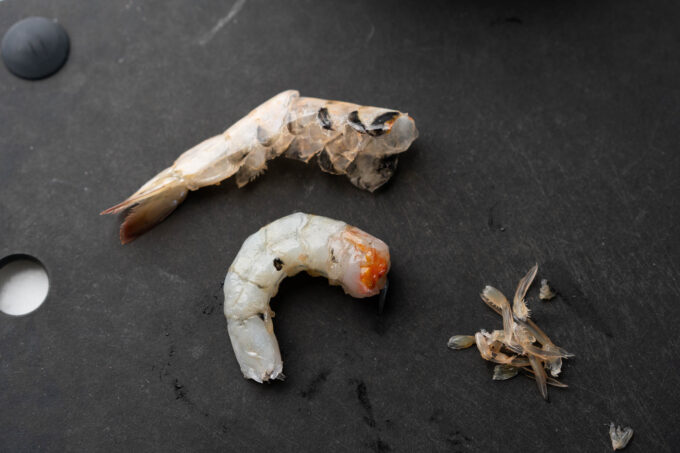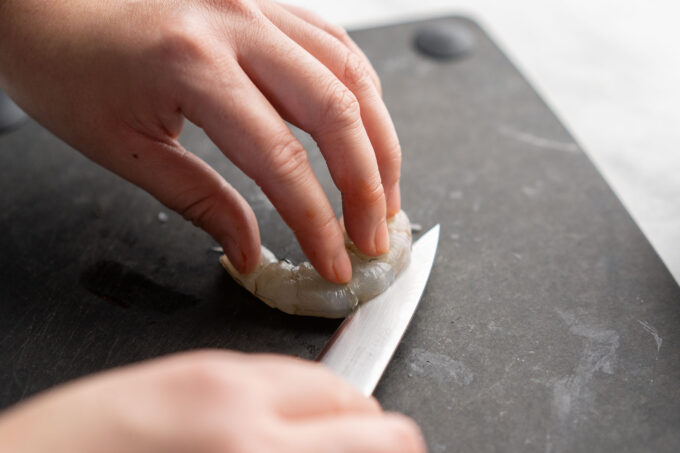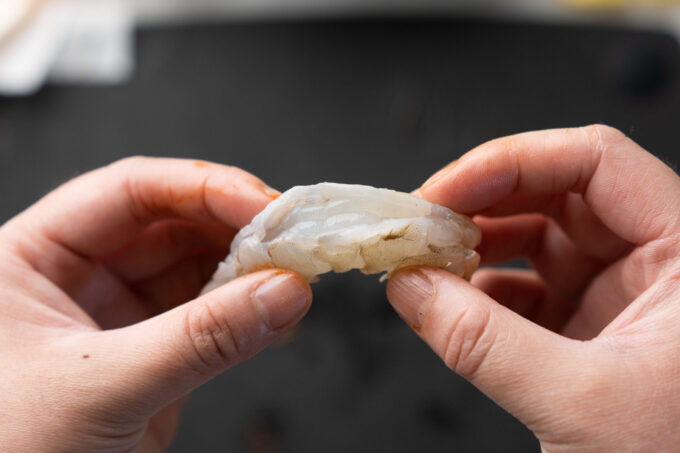Are you going to cook shrimp and want to know how to peel and devein them the right way? Some people might say you don’t even need to devein them, but we already know what we want to do, right?
You can clean shrimp quickly and devein them with or without shells. My mom taught me a really quick way to do it.
Deveining shrimp while leaving the shell on may sound tricky, but it’s actually a pretty straightforward process once you get the hang of it. Being able to devein shrimp without fully peeling them can be useful for recipes where you want the shells on for presentation or extra flavor. With just a paring knife, your fingers, and a few simple steps, you’ll be prepping shell-on shrimp like a pro.
Why Do You Need to Devein Shrimp?
You may be wondering why it’s even necessary to devein shrimp in the first place. Here’s the deal – the vein that runs along the shrimp’s back is actually its digestive tract. It contains grit and isn’t the most visually appealing part of the shrimp. While the vein isn’t harmful to eat removing it helps improve the texture of the shrimp and makes for a nicer presentation.
For small and medium shrimp deveining is optional since the veins are very tiny. But for larger shrimp especially those being served as an appetizer, it’s best to remove the vein. Leaving the shell on helps lock in moisture and flavor during cooking.
Step-By-Step Instructions
Deveining shrimp with the shell on just requires a few simple steps
Gather Your Tools
You’ll need:
- A sharp paring knife
- A pair of kitchen shears (optional)
- A cutting board
- A sheet pan lined with ice
- A large bowl filled with ice water
Prep the Shrimp
- Take the shrimp out of the fridge and spread them out evenly on the ice-lined sheet pan. This keeps them chilled as you work.
- If using frozen shrimp, place them in a bowl of cold water to thaw for 30 minutes first.
Make a Cut Along the Back
- Using kitchen shears or a paring knife, make a shallow cut along the back of each shrimp, cutting through the shell.
- The cut should run from the head end to the tail end of the shrimp. Don’t cut too deep.
- This exposes the vein so you can pull it out.
Remove the Vein
- Use the tip of the paring knife or your fingers to gently pull out the vein.
- Try to remove it in one piece if possible.
- Discard the veins as you go.
Rinse the Shrimp
- Once deveined, rinse the shrimp under cold running water to remove any remaining grit.
- Transfer to the bowl of ice water and refrigerate until ready to use.
And that’s it! With the vein removed but the shell still on, your shrimp are ready for cooking. Leaving the shell on will add lots of flavor to soups, pastas, seafood boils, and more.
Tips for Deveining Shrimp
Follow these tips for easy, effective deveining:
- Work over a sheet pan lined with ice to prevent shrimp from getting warm.
- For frozen shrimp, be sure to thaw completely before deveining.
- Make the cut along the back shallow, not too deep.
- Work slowly and carefully to remove the vein in one piece.
- Rinse well afterward to remove any remaining bits.
- Use fresh shrimp within a day or two for best flavor.
Common Questions
Here are answers to some frequently asked questions about deveining shell-on shrimp:
Is it safe to eat the shrimp vein?
While not unsafe, the vein can contain grit and isn’t very appealing. Removing it improves texture.
Do I really need to devein shrimp?
For medium or small shrimp, it’s optional. But for larger shrimp, especially being served whole, it is best to devein them.
Do I need special tools to devein shrimp?
No special tools needed! A paring knife and your fingers are all you need for this easy task.
Can I freeze shrimp after deveining with shells on?
Absolutely! Deveined, shell-on shrimp freeze beautifully for up to 3 months.
How do I thaw frozen deveined shrimp?
Place frozen shrimp sealed in a bowl of cold water and change the water every 30 minutes until thawed.
Perfecting Your Shrimp Deveining Skills
Like any new technique, it may take a few tries to get the hang of deveining shell-on shrimp. Be patient with yourself and go slowly at first. The more shrimp you devein, the faster and more efficient you will become. Pay attention to shrimp sizes and only devein larger ones. Soon, you’ll be prepping shrimp like a seafood market pro!
Deveining shrimp with the shell on lets you enjoy the benefits of both – tender, flavorful cooked shrimp with less work upfront. Give this handy method a try for your next shrimp dish. Your guests will be impressed with your skills.
:max_bytes(150000):strip_icc()/should-shrimp-be-deveined-1807012_round3-0b25e63190934368a703ce16b033edac.png)
How to devein shrimp without shell (w/ a knife)
It’s easier to devein shrimp that don’t have shells because you don’t have to work with a hard shell. The easiest way to devein shrimp without shells is using a knife, and it’s the most common method.

1. After you’ve removed the head and shell, lay your shrimp on its side.

2. Depending on the size of the shrimp, make a shallow cut (about ⅛ to ¼-inch deep) along the back of the shrimp, from the tail to the head. The slit only needs to reach where the intestinal vein lives.

3. Remove the tract and clean the shrimp in a bowl of water or running water.
What’s in the vein of a shrimp?

The shrimp’s intestine is the black line on its back. This is where all of its food gets broken down. k. a. poop) is located. If this sounds gross to you, it’s easy to see why some people choose to remove the veins from this part of the shrimp before cooking them.
On the other hand, you’ll notice that most Asian restaurants leave this in, and the customers don’t mind. I’m not here to tell you what’s right, but just to tell you some facts :).
